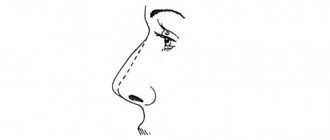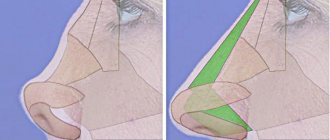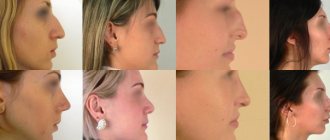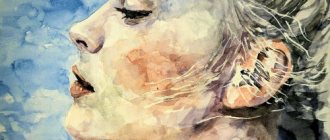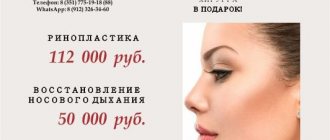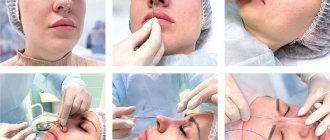| Section: Nose surgery (Rhinoplasty) Articles: History of rhinoplasty History and features of open rhinoplasty Structure of the nose Aesthetic analysis of the proportions of the external nose | Deviated nasal septum Computer modeling for rhinoplasty Questions from patients about rhinoplasty Rhinoplasty: results (before and after photos of nose surgery) Repeated rhinoplasty: results (before and after photos) |
Nose surgery or rhinoplasty, the consequences of which we are going to describe to you, is one of the most complex aesthetic operations. The slightest surgical error or carelessness of the patient in the postoperative period can be quite expensive. Side effects and possible complications after rhinoplasty will affect not only your emotional background and the aesthetics of your face. Health problems are also possible, and quite serious ones. Thus, we can conclude that after rhinoplasty the consequences may be different. This is always a certain risk. But this risk is typical for any surgical intervention. According to experts, in order to minimize the consequences of nose surgery, you need to provide yourself with sufficient motivation, the validity of which should not be questioned. Only in this case can you not only achieve an attractive and harmonious appearance, but also keep your nerves safe and sound, minimizing the consequences of rhinoplasty and avoiding negative phenomena.
How to choose a method for correcting a crooked nose?
We can say right away that this task is not as simple as it might seem at first glance. In order to correctly plan the course of the operation, the surgeon needs to take into account many factors and accurately determine what the main cause of the curvature is. This is usually clarified during the first consultation with the doctor.
In most cases, the main task is to simultaneously solve two problems: to restore the ability to breathe normally through the nose and to make it beautiful.
Aesthetic and late complications after rhinoplasty
Often, possible complications after rhinoplasty appear at a late stage, being a kind of “time bomb”. Such “bombs” (for example, adhesions after rhinoplasty) are planted by the surgeon himself during the operation. Of course, not on purpose. Alternatively, late complications may be a consequence of the individual reaction of the human body (for example, the nose is very swollen after rhinoplasty), which is not typical when making surgical changes.
Speaking about late complications, first of all, we mean keloid and hypertrophic rough scars that form in the surgical area, and are completely different from calluses after rhinoplasty. You can also talk about nasal deformities and breathing problems. They are caused by scars, poor blood supply and other nuances associated with the healing process. Surgical errors cannot be ruled out.
No less common are aesthetic aspects, such as a wide nose after rhinoplasty, associated with the patient's dissatisfaction with the way his nose looks after surgery. They can be divided into justified and unjustified.
- Justified dissatisfaction is a consequence of excessive or insufficient, from an objective point of view, correction of the nasal defect with which the patient was admitted to surgery, including the appearance of a callus after rhinoplasty. Also, it can be caused by significant deviations from the result that was originally planned, especially if we are talking about the presence of complications of a functional nature.
- Unreasonable dissatisfaction is associated with subjective or far-fetched reasons. For example, it could be the patient's mental disorder. But in most cases, we are talking about the time period that a person will need to adapt to the changes that have occurred in his appearance, the perception of which at the initial level may be negative even if the plastic surgeon did everything correctly.
Regarding the question of how long swelling lasts after rhinoplasty, it should be recalled that the nose does not take its final shape immediately after surgery. This may require some waiting, which, given the wearing of a cast after rhinoplasty, can reach a year or more. Not knowing or not wanting to take this into account, patients make hasty conclusions without asking the rhinoplasty specialist how long the swelling lasts. Needless to say, such judgments are categorically erroneous, especially if they are made before the cast is removed after rhinoplasty, the first postoperative swelling has subsided and full healing has been completed.
If there are real aesthetic or functional complications, repeat corrective surgery may be required using tampons after rhinoplasty. But this can be done at least a year after the first operation, in order to give the body the opportunity to fully recover. During this time, the surgeon himself will be able to evaluate the changes with greater objectivity.
What mistakes do surgeons make that lead to asymmetry?
During the operation, the doctor makes several mandatory mathematical measurements that help him understand what the outcome will be. If he is negligent at this point, after such a procedure the patient may have an asymmetrical shape of the nose. Most often this problem concerns plastic surgery of the nostrils or wings.
There are cases when excessive truncation of cartilage or bone tissue , and the healing process may not proceed correctly. For example, callus or other formations may appear that can affect the shape of the nose and its functionality. How are these and other defects eliminated? This is what revision rhinoplasty is for.
Complexity of the operation
The progress of the operation to correct the nasal septum can be complicated by certain factors. The main factor is the presence of a certain level of memory in bone and cartilage tissue. A feature of cartilage tissue is the ability to return to its original position. The soft tissues and cartilage structure also have tension, due to which they continue to act on the nose even after rhinoplasty. These features do not allow us to guarantee a 100% effect from the operation.
Note! The structures of the nasal tissues tend to return to their original state, which can negate all the work of plastic surgeons.
In some cases, a negative result may be the result of incomplete correction of the nasal septum, due to which the nose returns to its pre-operative shape. In the presence of a congenital defect, deviation may occur as a result of the resulting asymmetry.
To correct the tip of the nose, which consists only of cartilage, it will be necessary to carry out transplantation and suturing.
What you need to know about revision rhinoplasty?
Repeated plastic surgery can be done only if about six months have already passed after the first one. This operation is usually much more complicated. Why?
- Firstly, in all cases, a person is afraid to do it much more than the first time.
- Secondly , it is more difficult for the surgeon to choose the most effective technique due to the presence of scars and defects after the first procedure.
- Third, it usually takes longer than regular surgery. This means that it can be done for almost two hours instead of one.
- Fourthly , a person takes longer to recover from it, since rehabilitation is more difficult. The swelling goes down more slowly and if the patient does not comply with the doctor’s recommendations, there is a high risk of tissue scarring. Sometimes this may take about two years.
Therefore, it is very important for the patient to take very seriously the process of preparing the body for surgery and to follow all the doctor’s recommendations during the rehabilitation process.
There are times when only minor adjustments need to be made. In such cases, the doctor may decide to perform the operation under local anesthesia, but if the case is more complex, then you need to adjust to general anesthesia.
If you turn to a good surgeon for help, you can not be afraid and be sure that everything will be done in the best possible way. An experienced doctor will be able to reassure his patients during the consultation that everything will be fine. He will try to conduct a more thorough examination and plan the course of the operation to the smallest detail.
And yet, it is worth saying that not in all cases, repeated surgery to correct a crooked nose will help completely correct the problem. A true professional will definitely tell the patient what results he can achieve and what he cannot achieve. Such honesty and open communication even before the procedure usually helps a person get into the right psychological frame of mind.
Rehabilitation complications
Complications that arise during the rehabilitation period (for example, ichor after rhinoplasty), for the most part, are expected. You just need to prepare for them and endure them, since such troubles cannot be avoided.
- Hematomas in the nasal area, swelling and bruising after rhinoplasty under the eyes.
- Severe swelling, which causes not only problems with the sense of smell, but also difficulty breathing through the nose. Sometimes swelling of the nose after rhinoplasty can completely prevent access to oxygen through the nose.
- Partial (tip of the nose) or complete numbness of tissues. At least this prevents pain from appearing after rhinoplasty.
Although these phenomena bring discomfort, they are not full-fledged complications. If you behave correctly, using the same patches after rhinoplasty, they will disappear in one to two weeks. The only thing that can persist for a longer period is the phenomenon in which the nose swells slightly after rhinoplasty. As practice has shown, the question of how long swelling lasts after rhinoplasty is of great concern to patients. Well, the swelling goes away completely within a few months. And it does not cause much discomfort for the patient.
Much more dangerous to health than nasal swelling after rhinoplasty are the following complications, which do not occur during a stable rehabilitation period.
- Infection and accompanying complications of various types, accompanied by pain after rhinoplasty. You can fight the infection with antibiotics and other medications, which are prescribed according to the characteristics of the complications.
- Skin necrosis, necrosis of the nasal structures of the cartilaginous and bone type, which is much more serious than bruises after rhinoplasty. Caused by excessive cauterization and cutting during the rhinoplasty process. It may also be a consequence of poor blood supply and postoperative infection of sutures after rhinoplasty. Tissues recognized as dead cannot be restored. They are removed, after which healing is carried out again.
- Broken seams after rhinoplasty. If you notice a broken seam in time, then there will be no danger to the patient. You simply need to re-debride the incision after surgery and stitch your nose after the rhinoplasty cast is removed. Even if these measures are not carried out, in most cases, serious health consequences are not expected. Of course, except for the unaesthetic scar after rhinoplasty that will be formed in this area.
There is also an impressive number of complications that occur extremely rarely, but carry a serious postoperative danger even after the removal of the cast after rhinoplasty. Therefore, if after rhinoplasty there is a suspicion that the recovery period is not proceeding as expected, you should immediately contact a plastic surgeon who will conduct a full examination after removing the plaster after rhinoplasty.
How is the operation performed in other cases?
- When the cause of asymmetry is a significant curvature of the septum , they resort to septoplasty.
- If the back is curved, surgery using autografts may be required. They are usually taken from the patient's own cartilage tissue.
- When the cause of asymmetry is an abnormal structure of the tip or wings , suturing the ligaments or changing the size of the nostrils, as well as reconstructive rhinoplasty, may be required.
How much does this procedure cost?
There is no one price, as it can be different in each case. The exact amount can only be found out after a medical examination and consultation with a surgeon.
- Initial consultation on rhinoplasty₽3,000
- Including professional 3D modeling
- Repeated consultation on rhinoplasty₽6,000
- Primary full rhinoplasty₽300,000
- * First category of difficulty
- Primary full rhinoplasty₽330,000
- * Second category of difficulty
- Primary full rhinoplasty₽370,000
- * Third category of difficulty
- Primary full rhinoplasty₽400,000
- * Fourth category of difficulty
- Primary rhinoplasty of Asian nose₽420,000
- * The complexity of the category can only be determined during an in-person examination during a consultation with a surgeon. Assessment of the complexity category of rhinoplasty is not carried out using photographs or remotely.
- The price for all plastic surgeries includes: hospital stay, general anesthesia, all subsequent dressings and examinations throughout the year.
- ** In 99% of cases, septoplasty and vasotomy are performed simultaneously according to indications. These surgeries are included in the cost of a full rhinoplasty.
Surgeon consultation
Standard recommendations
- Stop smoking a couple of weeks before rhinoplasty, due to the negative effects of nicotine on tissue repair after surgery.
- Stop taking aspirin and other medications that impair blood clotting.
- Refusal of physical activity during the rehabilitation period, in order to avoid fluctuations in blood pressure, damage to the nose and the appearance of ichor after rhinoplasty.
- Sleep exclusively on your back, with the head of the bed in a raised position. This will help get rid of swelling more quickly.
- For two weeks after rhinoplasty, you should not go to the pool, bathhouse, sauna, or lie in a hot bath. The bandage should always be dry.
- You cannot plan to conceive a child from six months to a year.
